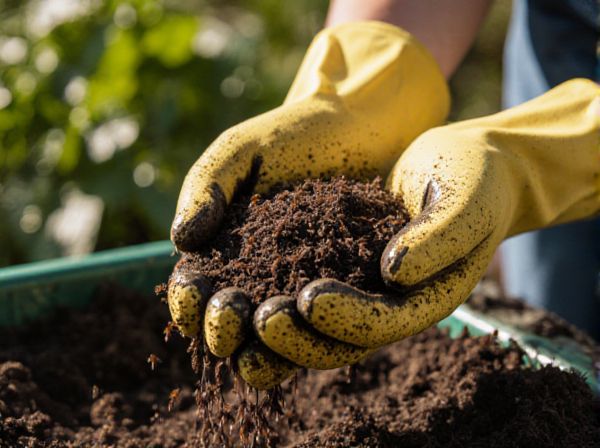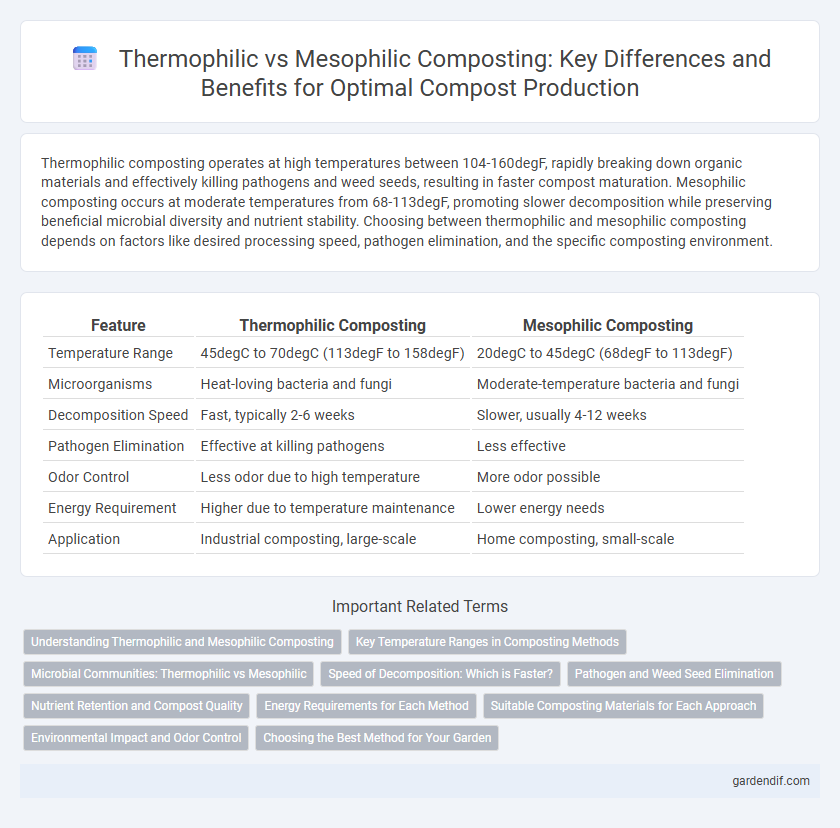
Thermophilic composting vs mesophilic composting Illustration
Thermophilic composting operates at high temperatures between 104-160degF, rapidly breaking down organic materials and effectively killing pathogens and weed seeds, resulting in faster compost maturation. Mesophilic composting occurs at moderate temperatures from 68-113degF, promoting slower decomposition while preserving beneficial microbial diversity and nutrient stability. Choosing between thermophilic and mesophilic composting depends on factors like desired processing speed, pathogen elimination, and the specific composting environment.
Table of Comparison
| Feature | Thermophilic Composting | Mesophilic Composting |
|---|---|---|
| Temperature Range | 45degC to 70degC (113degF to 158degF) | 20degC to 45degC (68degF to 113degF) |
| Microorganisms | Heat-loving bacteria and fungi | Moderate-temperature bacteria and fungi |
| Decomposition Speed | Fast, typically 2-6 weeks | Slower, usually 4-12 weeks |
| Pathogen Elimination | Effective at killing pathogens | Less effective |
| Odor Control | Less odor due to high temperature | More odor possible |
| Energy Requirement | Higher due to temperature maintenance | Lower energy needs |
| Application | Industrial composting, large-scale | Home composting, small-scale |
Understanding Thermophilic and Mesophilic Composting
Thermophilic composting operates at high temperatures between 45degC and 70degC, accelerating organic matter breakdown and effectively eliminating pathogens and weed seeds. Mesophilic composting occurs at moderate temperatures of 20degC to 45degC, promoting slower decomposition through a diverse microbial community suited for gradual organic matter stabilization. Understanding these temperature-based phases is crucial for optimizing composting efficiency and tailoring processes for specific waste types and environmental conditions.
Key Temperature Ranges in Composting Methods
Thermophilic composting operates at temperatures between 45degC and 70degC, optimizing the breakdown of organic matter through thermophilic microbes that accelerate pathogen destruction and weed seed elimination. Mesophilic composting occurs at cooler temperatures, approximately 20degC to 45degC, favoring mesophilic microorganisms that decompose organic material at a slower pace, resulting in longer composting times. Understanding these key temperature ranges is essential for selecting the appropriate composting method based on desired speed, pathogen reduction, and material stability.
Microbial Communities: Thermophilic vs Mesophilic
Thermophilic composting hosts heat-loving microbial communities, primarily thermophilic bacteria and fungi, that thrive at temperatures between 45degC and 70degC, accelerating organic matter breakdown and pathogen kill rates. Mesophilic composting involves mesophilic microbes active at moderate temperatures (20degC-45degC), promoting the initial decomposition stages with a diverse bacterial population. The dynamic shift from mesophilic to thermophilic phases reflects microbial succession critical for compost maturation and nutrient cycling efficiency.
Speed of Decomposition: Which is Faster?
Thermophilic composting accelerates the speed of decomposition by maintaining temperatures between 45degC and 70degC, which promotes rapid breakdown of organic matter through the activity of heat-loving microbes. Mesophilic composting operates at lower temperatures, typically between 20degC and 45degC, resulting in slower microbial activity and extended decomposition times. Consequently, thermophilic composting is significantly faster, producing finished compost within weeks, while mesophilic composting may take several months.
Pathogen and Weed Seed Elimination
Thermophilic composting reaches temperatures between 55degC and 70degC, efficiently eliminating pathogens and weed seeds due to sustained high heat. Mesophilic composting operates at lower temperatures, typically 20degC to 45degC, which may not reliably kill all harmful microorganisms or weed seeds. The higher microbial activity and thermal conditions in thermophilic composting ensure safer, more sanitized compost for agricultural and gardening use.
Nutrient Retention and Compost Quality
Thermophilic composting operates at higher temperatures (45-70degC), accelerating organic matter breakdown and effectively killing pathogens, which enhances nutrient retention by minimizing nutrient loss through volatilization. Mesophilic composting, occurring at moderate temperatures (20-45degC), preserves more microbial diversity but results in slower decomposition and potential nutrient depletion due to longer exposure to leaching. The resulting compost quality from thermophilic processes typically shows higher nitrogen content and pathogen-free stability, whereas mesophilic compost may contain greater microbial activity but lower overall nutrient density.
Energy Requirements for Each Method
Thermophilic composting demands higher energy input due to elevated temperatures ranging from 45degC to 70degC, accelerating microbial activity and organic matter breakdown. In contrast, mesophilic composting operates at moderate temperatures between 20degC and 45degC, requiring less energy but resulting in slower decomposition rates. The increased energy requirement in thermophilic composting supports rapid pathogen destruction and faster stabilization of compost.
Suitable Composting Materials for Each Approach
Thermophilic composting suits high-nitrogen materials like food scraps, manure, and green yard waste, promoting rapid decomposition at temperatures between 40-70degC. Mesophilic composting efficiently processes a broader range of organic inputs such as leaves, wood chips, and paper products by maintaining moderate temperatures of 20-40degC. Optimal material selection ensures microbial activity stability, nutrient retention, and pathogen reduction tailored to either thermophilic or mesophilic phases.
Environmental Impact and Odor Control
Thermophilic composting operates at higher temperatures between 45-70degC, accelerating organic matter breakdown and effectively killing pathogens, which reduces harmful emissions and odors significantly compared to mesophilic composting that occurs at 20-45degC. The higher temperatures also minimize greenhouse gas release, such as methane and ammonia, and control odor by rapidly stabilizing the compost material. Mesophilic composting, while slower and less energy-intensive, often produces stronger odors due to prolonged microbial activity and incomplete decomposition, potentially impacting local air quality.
Choosing the Best Method for Your Garden
Thermophilic composting rapidly breaks down organic matter at temperatures between 113degF and 160degF, effectively killing pathogens and weed seeds, making it ideal for gardeners seeking quick, sterile compost. Mesophilic composting operates at lower temperatures around 68degF to 113degF, promoting gradual decomposition and preserving beneficial microbes essential for soil health. Selecting between thermophilic and mesophilic composting methods depends on your garden's scale, the types of organic waste available, and the desired composting speed and quality.
Thermophilic composting vs mesophilic composting Infographic

 gardendif.com
gardendif.com